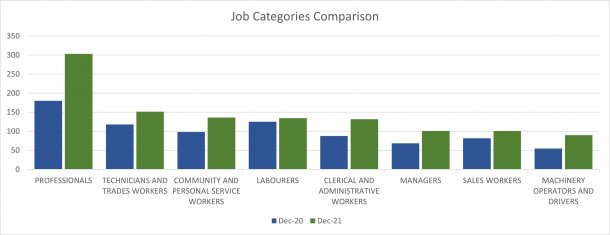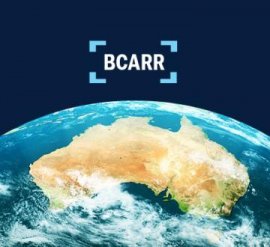-
Featured Items
-
Featured Resources
 Funding & Grants
Don't miss out on funding opportunities. Stay informed with our up to date online listings and email notifications.
Read More
Funding & Grants
Don't miss out on funding opportunities. Stay informed with our up to date online listings and email notifications.
Read More
 Skilled Migration
Our services help both applicants and employers, to learn more, develop plans, submit applications, and settle in.
Read More
Skilled Migration
Our services help both applicants and employers, to learn more, develop plans, submit applications, and settle in.
Read More
 Research and Analysis
Good research and analysis makes the case. How can our resources and services help your project or application?
Read More
Research and Analysis
Good research and analysis makes the case. How can our resources and services help your project or application?
Read More
 Information & Data Resources
With resources like REMPLAN, Regional Knowledge Base, and decades of data, discover how we can help your project.
Read More
Information & Data Resources
With resources like REMPLAN, Regional Knowledge Base, and decades of data, discover how we can help your project.
Read More
-
Stay InformedSubscribe to one or more of our regular email subscriptions, to be kept up to date on news and funding opportunities for the region
-
-
Our Region
- Our Region
- Regional Plan
- Regional Data
- Current Regional Issues
- Population Migration Analysis for 2016-21
- Job Vacancies Continue at All-Time High
- National Debt - What it Means for Our Economy?
- The True Value of Home Solar
- The Economic Impacts of Local Government Amalgamations
- State of the Regions Report 2014-15
- Antifragility - A different take on regional economic development
- Biohubs - Collaborative Waste Management
- Attracting New Residents
- Socio-Economic Impacts of the Murray Darling Basin Plan
- Murray Darling Basin Water Recovery
- Growing Businesses
- The Northern Inland Economy
- Geographical Overview
- Major Industry Sections
- Our Services
- Grants and Funding
-
Skilled Migration
- Skilled Migration
- Skilled Employer Sponsored Regional Visa
- Skilled Work Regional Visa (subclass 491)
- Temporary Seasonal Workers
- Designated Area Migration Agreement (DAMA)
- Helpful Information for Visa Holders
- Information for Employers
- Case Studies
- Payment Details
- Advice & Further Information
- Contact Details
- News & Events
-
Our Projects
- Our Projects
- Current Projects
- The Welcome Experience
- Come On Inland
- Wool Works - Wool Training Schools
- Skilled Migration
- Metal Works - Welding and Fabrication Schools
- Stories of Resilience
- Alt Brothers Beekeeping - Glen Innes
- Carelle's Toy Store - Glen Innes
- Greenhill Orchards - Arding
- Gwydir Meats - Warialda
- Kaputar Motors - Narrabri
- Moonbi General Store - Moonbi
- Sandstock - Tingha
- Sherelle Fashions - Tenterfield
- Sleepy Merino - Inverell
- Tenterfield Chamber of Toursim, Industry and Business - Tenterfeild
- The Welders Dog - Armidale
- Walcha Veterinary Supplies - Walcha
- AGCAP - Agribusiness Careers & Professions
- Northern Inland Regional Investment Profile
- Past Projects
- Digital Economy Strategy
- Business Growth Project
- Go Digital
- How to Start an Online Business
- Create Your Website Using Squarespace
- How to Edit Your Squarespace Site - Part 1
- How to Edit Your Squarespace Site Part 2
- Add a Shop to Your Squarespace Site
- Start a Blog and Find out What Customers are Searching
- 14 Tips For a Better Blog Post
- Which Social Media Platforms are Best for Your Business
- How to Use Facebook Effectively For Your Business – Part 1
- How to Use Facebook Effectively For Your Business – Part 2
- Instagram Tips for Business
- Catching Up, More Instagram & Dealing with Haters
- Getting Started with Twitter for Business
- Social Media Scheduling Tools
- How to Start an Etsy Shop – Part 1 – Research
- How to Start an Etsy Shop – Part 2 – Signup
- Online Security for Your Business
- Product Photography and Website Images: Your Guide
- 5 Tips to Improve your Productivity in your Business
- Best Online Business Resources
- How to Improve Your Communication Skills and Win More Clients
- NBN Coordinator
- Putting Power Back in the Regions
- Road Freight Study
- Town Audit Benchmarks
- Food and Wine
- Youth Survey
- Digital TV Switchover Assistance
- Northern Inland Transport Guide
- Live.Train.Work
- Northern Inland Innovation Awards
- Northern Inland Innovation Awards - 2017
- Northern Inland Innovation Awards - 2016
- Northern Inland Innovation Awards - 2015
- Northern Inland Innovation Awards - 2014
- Northern Inland Innovation Awards - 2013
- Northern Inland Innovation Awards - 2012
- Norther Inland Innovation Awards - 2011
- Prime Super Northern Inland Innovation Awards - 2010
- Prime Super Northern Inland Innovation Awards - 2009
- Northern Inland Innovation Awards - 2007
- Northern Lights Project
- NBN Smart Home
- Murray Darling Basin
- Moree Plains Business Workshops
- Namoi Investment Prospectus
- Industrial Land
- Bioenergy and Local Electricity Retailing
- Northern Inland Business Energy Assessment
- Skills for the Future
- Impacts of COVID-19 on Businesses
- Past Projects of NIRDB
- Aboriginal Employment and Enterprise in the Gunnedah Region
- Art as an Industry
- Aviation Survey
- Farm Forestry - Northern Inland Forestry Investment Group
- New England North West Film Strategy
- Northern Inland Excellence in Business Awards
- Food and Wine 2003 - 2008
- Prime Super Northern Inland Innovation Awards 2009
- Regional Business Networking Program
- Regional Leadership Course 2008
- Viticulture Strategy 2002-2003
- About Us
- Contact Us
- Other Resources
- Privacy and Legal
- Search
Back to Newsletters

January 2022 Newsletter
Monday 31st of January 2022
In this Issue
- Welcome from the Chair
- Job Vacancies and Demand for Professionals Continues to Increase
- January Round of 491 ROI’s Close Today
- Unlocking the Potential of Australian Companies
- Online Portal Provides Data Highlighting Regional Progress
- Support for Agricultural Shows and Field Days
- Featured Grants and Funding Opportunities
Welcome from the Chair

Dear Northern Inlanders,
Welcome to our first newsletter for 2022! I hope you had a refreshing and enjoyable Christmas and new year break and the opportunity to catch up with family and friends. Our Committee and Staff are looking forward to working with you in the year ahead to help our region prosper and grow as we look to the future and recover from the many trials the last couple of years have presented us.
Our communities’ leaders make a positive contribution to our lives every day, and it is fantastic to see some of them recognised each year with local Australia Day Awards. Special congratulations go to the two recipients of OAMs in our region, Dr Ramin Samali of Tamworth, for his service to medicine as a urologist, and Mrs Denise Sullivan of Hillvue, for her service to the community of Tamworth.
The struggle to fill job vacancies in the region remains at the forefront of our minds. As published by the Australian Government, the number of online job vacancies in our region continues at record highs, with 1,202 jobs listed in December, a trend that is also occurring at the state level. Our analysis below shows that the number of vacancies in our region is increasing across all ANZSCO job groups, particularly professionals, which has grown by 68% compared to the same time last year. More than half of the job vacancies in our region are in the three ANZSCO groups of Professionals, Technicians and Trade Workers, and Community and Personal Services Workers.
Although the year is still young, there are a large number of grants currently open, and many of them will be closing soon. So be sure to check out our searchable grants database and subscribe to our two monthly grants newsletters so you can apply for funding to help you in your future endeavours for your business or community.
Regards,
Russell Stewart
Chair
Job Vacancies and Demand for Professionals Continues to Increase
The Australian Government's job vacancies data for December 2021 has shown that the number of job vacancies advertised online for the Northern Inland continues to reach record highs.
The number of vacancies for the region reached a record level of 1,202 in November 2021, and in December 2021, there were 300 more jobs advertisements than in December 2020. The upward trend of vacancies in our region and NSW has been consistent since the public health orders in mid-2020. Records are also occurring at the state level, with over 81,000 jobs advertised online in December 2021 in NSW, an increase of 22,700 jobs from December 2020.
Professionals were the most sought after in December 2020 and 2021 and now make up a quarter of the job advertisements. While the need for all skill groups has increased compared to December 2020, professionals had the most significant increase, up by 68%. Over half the job vacancies listed online for our region in December were for the three ANZSCO groups of Professionals, Technicians and Trade Workers, and Community and Personal Services Workers.
Additional data, including monthly data releases, is available on the Australian Government’s Labour Market Information Portal.
January Round of 491 ROI’s Close Today
In January, the NSW Government has been running its third round of Registrations of Interest for 491 Visa nomination, which closes today. Interested applicants must receive an invitation to apply from the NSW Government through this process before submitting a full application for nomination.
We look forward to receiving full applications from those who were invited to apply from the NSW Government in this round. Be sure to follow the steps we have provided on our website on how to apply for a 491 Visa to ensure that you provide all the required information with your application. We also have a well-established Skilled Migrant Settlement Support Group on Facebook for skilled migrants moving to our region. In this group, you can find assistance from other Skilled Migrants to find accommodation and answer any general questions about the region you may have.
As with previous rounds, if you submitted a registration of interest and have not received an invitation by ten days after the close of the round, you should assume you will not receive an invitation from that round. While it is disappointing if you do not receive an invitation, the NSW Government plans to conduct another round in March this year. Those who have not received an invitation and meet the criteria may submit a registration of interest again. Applicants are not penalised for being unsuccessful in prior rounds.
Please keep in mind that the NSW Government determines invitations to apply, and we cannot influence their decisions for this invitation process. We can only respond to enquiries about this first step in the 491 Visa process that are general in nature. Further information about how to register your interest with the NSW Government and the online form is available on the NSW Government’s website. We also recommend reading through their frequently asked questions about the ROI process which has information for 190 and 491 Visas.
Although we enjoy meeting Skilled Migrants who move to our region, our office is currently closed to visitors for the safety of our staff and their families due to the current spread of COVID. While we appreciate that it can sometimes feel easier to talk face-to-face, we cannot make exceptions. Our Skilled Migration Officer, Gary Fry will be available to assist where possible for those looking to apply to the Northern Inland by phone on 6771 0700 or by email at migration@rdani.org.au
Unlocking the Potential of Australian Companies
New research from the CSIRO and the Business Council of Australia has highlighted the potential of collaborations between research, industry and the business sector to fuel the recovery of our economy. Their report, Unlocking the Innovation Potential of Australian Companies, examines the role of collaboration in addressing three long-term challenges for the Australian economy:
- Low productivity, low business investment and stagnation in several industries.
- Low economic diversity in its industrial base and exports, and low diversity in its trade and investment partners.
- Disruption risks from emerging technologies.
CSIRO Chief Executive Dr Larry Marshall said Australia’s world-class science and research can supercharge Australian industries when they work together to build real-world solutions. “Australia has the potential to lead the world in a few key markets by harnessing the power of science-driven innovation, using it to ‘build back better’ from the pandemic and embed resilience to future disruptions into their very DNA. Commercialisation is an engine that will drive us to a technology-led recovery, but innovation takes a team. To really deliver on a bold, technology-led recovery, we will need business and research driving together to win.”
Business Council of Australia Chief Executive Jennifer Westacott AO said giving businesses the right tools to innovate, collaborate and turn our world-class ideas into new jobs and industries will be crucial to securing our economic future. “Whether it’s our world-beating miners, food producers or service exporters, Australian businesses are some of the most adaptive in the world, and our research institutions are globally respected. As we emerge from the COVID-19 pandemic, we have to take a team-Australia approach to double down on our advantages, drive commercialisation and turn our ideas into jobs. We can’t afford to be a nation that gives our best ideas away to be scaled up and commercialised overseas. “
The report draws on interviews and case studies from executives at some of Australia’s largest and most innovative businesses. It also looks at existing research on ways organisations can become ‘innovation active’. Independent of their size, companies that are innovation active are twice as likely to report increased productivity and almost all experience benefits such as improved customer service or increased revenue.
The report is provided as a how-to guide for Australian businesses to position themselves for the future. It focuses on the practical steps to overcome barriers to commercialisation for a technology-led economic recovery. It identifies four barriers to commercialisation and addresses them with four corresponding enablers to overcome these barriers, as shown below.
The full Unlocking the Innovation Potential of Australian Companies Report is available on the CSIRO’s website.
Online Portal Provides Data Highlighting Regional Progress
Did you know the Northern Inland has over 20,000 actively trading businesses and over 65% of our businesses are non-employing? Or that 47% of our population is aged between 25 and 65, or that our projected population in 2030 is over 194,00, which is 4,000 more than today?
This data and much more can be found in the Progress in Australian Regions and Cities Dashboard by the Bureau of Communications, Arts and Regional Research (BCARR). They have recently completed their annual data review and updated the dashboard to include Australian cities.
It provides vital data for decision-makers at the individual, community, government and industry levels. It tracks the performance of Australian regions and cities across seven themes:
- The labour market
- Infrastructure
- Housing
- Economic activity
- The environment
- Demography
- Wellbeing
The dashboard provides information on how our regions and cities are progressing by tracking trends over time. The interactive dashboard collates a wide range of data from multiple sources into one location, including data from 2006 onwards and population projections up to 2032.
Data is available for a range of geographic levels, including national, state, regional, Local Government Area, and city (which includes Tamworth and Armidale in our region). To access the data for our region, or a Local Government Area, once you enter the portal, select ‘Regional Profiles’ and then:
- For our region – Select Region Category ‘Statistical Area Level 4’ and Region Search ‘New England and North West’
- For an LGA – Select Region Category ‘Local Government Areas and Region Search for LGA name.
Additional data for our region is also available on the data section of our website.
Support for Agricultural Shows and Field Days
In the last two years, the public health orders have made it particularly tough for the many agricultural shows in our region. Our shows are a key date on the calendar for our communities that provide economic and social benefits. To help show organisers recover and move forward, the Federal and State Governments are providing financial support through the Supporting Agricultural Shows and Field Days, and the Country Shows Support Package.
The Federal Government is providing $7.9 million of support through the AgShows and Field Days Stream of the Supporting Agricultural Shows and Field Days (Round 2). This grant supports operational costs for events that were scheduled in 2021 but cancelled due to COVID-19. Applicants will be able to claim for eligible expenditure in 2021 with a maximum amount of funding based on the number of attendees to the show in 2019, as follows:
- Small agricultural shows and field days (Up to 1,999 attendees) - Up to $10,000
- Medium agricultural shows and field days (2,000 to 4,999 attendees) - Up to $15,000
- Large agricultural shows and field days (5,000 attendees and up) - Up to $70,000
Deputy Prime Minister and Member for New England Barnaby Joyce said the program is a way to give show societies a much-needed cash injection after the disruptions caused by the COVID-19 pandemic. “The support will go further than just dollars and cents. Economics aside, agricultural shows and field days are a great day out and provide the much-needed opportunity for communities to come together, catch up and support each other.”
Member for Parkes, Mark Coulton also welcomed the funding highlighting that Agricultural shows and field days are one of the biggest highlights on the social calendar for many communities and provide a much-needed opportunity for locals to come together. “As a former ag show president myself, I know just how much hard work and effort goes into ensuring they go off without a hitch, which is why the past two years of cancellations have been particularly difficult for local committees, and communities who rely on the social and economic benefits these events provide. These grants provide show societies and field day organisations with the confidence they need to go ahead and plan their events in 2022 and beyond.”
Applications for Supporting Agricultural Shows and Field Days Round 2 opened last Friday and will close on the 17th of February 2022.
The NSW Government is offering support through the Country Shows Support Package. $5 Million will be distributed under the program, with 190 agricultural shows that are being staged in 2022 able to apply. The amount of funding available per show is based on the highest number of attendees to the show between 2018 and 2021, grouped as follows:
- Small shows (up to 1,999 attendees) - $15,000
- Medium shows (2,000 to 4,999 attendees) - $30,000
- Large shows (5,000 attendees and over) - $45,000
“It’s been a tough few years for country shows, with drought, bushfires, storms, floods and COVID-19 disrupting plans, but as they say, the show must go on and these grants will help make that happen,” said Deputy Premier and Minister for Regional NSW, Paul Toole. “Country shows are the heartbeat of so many rural communities – they not only celebrate the best of the best in the community but allow visitors to experience the tastes, sights and sounds of the bush. These grants will provide certainty to show organisers that they can lock in suppliers, hire equipment and purchase goods, which is also great news for local businesses.”
Featured Grants and Funding Opportunities
Below are some featured grants and funding opportunities from the multitude of open grants listed in our Grants and Funding Opportunities Database on our website. Our website is updated weekly with new listings and updates and all are applicable to our region, so it is a great resource if you are looking for funding for a specific project.
You can also sign up to our free Business and Infrastructure Funding Opportunities and the Community Grants and Award Programs newsletters through the simple form located in the footer of our website, www.rdani.org.au, to receive monthly summaries of current grants.
Emerging Priorities Program (EPP)
Closes: 10th of February 2022 - 9:00 pm
Value: Unspecified
Run By: Australian Government Department of Education, Skills and Employment
Acknowledging the continuing impacts of COVID-19 on schools and students, the Australian Government is bringing forward all remaining funding in the EPP to the 2021–22 financial year, enabling up to $11.2 million (GST exclusive) in funding to be available for projects that meet the objective and outcomes of the EPP.
The intended outcomes of this grant opportunity are:
- improved educational outcomes for school students
- improved engagement of school students and their families with school education
- improved wellbeing of school leaders, teachers, and school students.
Examples of emerging priorities include:
- targeted educational support for students, including responding to the impacts of COVID-19
- mental health and wellbeing support for students, teachers, and school leaders, including responding to the impacts of COVID-19
- support for disengaged students to improve educational outcomes
- support for school attendance and completion
- support for career development of students, including to explore pathways for post-school destinations
- research and analysis to address the impacts of unexpected events, including COVID 19, on educational outcomes for students.
NAIDOC Local Grants Program
Closes: 22nd of February 2022 - 9:00 pm
Value: Average of $200 to $1,000
Run By: National Indigenous Australians Agency
This grant round provides funding to Indigenous and non Indigenous organisations to contribute to the costs of local and regional NAIDOC activities across Australia. NAIDOC activities should align with the 2022 theme ‘Get Up! Stand Up! Show Up!’.
The objectives of the program are to promote:
- the expression, engagement and conservation of Indigenous Australians’ cultures
- Indigenous Australians’ participation in the social and economic life of Australia through healing, and strengthening the capability, governance and leadership of Indigenous Australians, organisations and communities,
- broader understanding and acceptance of the unique place of Indigenous Australians’ cultures in Australian society.
Coles Nurture Fund
Current Round Closes: 25th of February 2022 - 5:00 pm
Value: Up to $500,000
Run By: Coles
Coles launched the Nurture Fund to help small and medium sized businesses innovate and grow. Since it's establishment, they have offered more than $28 million in financial support to more than 60 Australian food and liquor producers.
From Australia’s first quinoa processing facility, to chickpea tofu, to home grown garlic and to Australian first prawn farming technology, the Coles Nurture Fund is helping Aussie producers bring their big ideas to life.
Small and medium sized businesses can apply for a grant of up to $500,000 to help them develop new market-leading products, technologies and processes.
Before and After School Care - Establishment Grants - Round 3
Closes: 25th of February 2022 - 5:00 pm
Value: Up to $40,000
Run By: Australian Government Department of Education
The Establishment Grant Program is designed to encourage and support the establishment of new services to increase the number of approved BASC places for NSW Government primary school children.
The total funding pool available through the Establishment Grant Program is $4,000,000 (including GST). Applicants may seek up to $40,000 (including GST) to support establishment and operating expenses, pending eligibility as detailed in these guidelines.
At its discretion, the NSW Department of Education (the Department) may prioritise applications against some or all of the following criteria:
- The level of demonstrated demand for the service
- The number of NSW Public School students as a percentage of total enrolments
- Whether the service is operating in a geographical area of low socio-economic advantage, as categorised by the SEIFA Index of Relative Socio-Economic Advantage and Disadvantage.
Related Pages







 Latest News
Latest News





